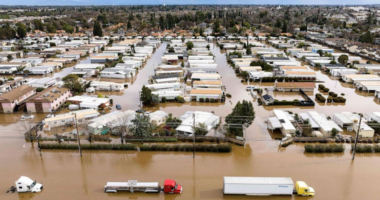Climate, Health and Equity Brief
Trapped heat, intensifying hurricanes and a sweltering summer
June 1, 2022

The Climate, Health & Equity Brief is GMMB’s take on the week’s news on the current impacts of climate change. If you haven’t subscribed yet, you can do so by clicking here.
Hot Topic: NOAA. Three reports from the National Oceanic and Atmospheric Administration (NOAA) released this week tell a sobering story about the increased heat being trapped in our atmosphere by greenhouse gas emissions and the very real impacts we can expect to feel this year.
First, NOAA’s Annual Greenhouse Gas Index found that human-caused emissions of CO2, methane and nitrous oxide trap 49% more heat today than when the Index began in 1990. And despite increasingly dire warnings from the IPCC and the fact that some countries have started to implement changes, the global rate of emissions is still accelerating. The annual increase in CO2 emissions over the last year was 73% higher than it was throughout the 1990s, and levels of methane in the atmosphere increased more rapidly over the past two years than at any other time since ongoing measurement began in 1983.
Two more reports from NOAA this week predicted intensified weather this summer. Nearly every state in the U.S. is predicted to have higher-than-average heat from now through August. And across the West, increased heat is paired with predictions of below-average rainfall, which can only exacerbate the devastating drought and wildfires that are increasingly becoming the new normal for nearly 80 million Americans.
By contrast, NOAA predicts above-average rainfall along the Atlantic Coast and the 7th consecutive above-normal Atlantic hurricane season for the U.S., fueled by warmer water in storm-forming areas. NOAA predicts that the Atlantic Coast can expect as many as 21 named storms this year, including up to 10 hurricanes.
Findings released this week about the long-term health impacts of climate change make NOAA’s reports even more concerning. One study of two million Canadians found that people who lived within 30 miles of a wildfire over the past decade have a 10% greater risk of brain cancer and 4.9% greater risk of lung cancer compared to those not exposed to wildfire pollutants.
Finally, a global study conducted by The InterAcademy Partnership underscored the fact that billions of people face health threats from climate change. According to the study, climate change is fueling destructive impacts—including but not limited to wildfires and extreme weather—that lead to a wide range of health conditions, including cardiovascular and respiratory disease, water- and food-borne illness, malnutrition and mental disorders worldwide.
—Matt & Traci, GMMB
Human Health
A new report warns that climate impacts including extreme weather, decreases in crop yields and changes in disease distribution are fueling a wide range of health hazards for billions of people globally, including cardiovascular and respiratory ailments, malnutrition and mental health disorders. (Earth.com)
Less than two weeks after an unprecedented heatwave assaulted Bangladesh and India, unseasonal rains fueled by warming temperatures have set off catastrophic floods and landslides that have killed at least 60 people and left millions more homeless. (The New York Times)
The largest study to date on the impact of increased heat on sleep quality hyperlink found that higher temperatures led to worse sleep outcomes, eroding an average of 45 hours of sleep per person—or up to an additional 11 nights of poor sleep—each year. (Grist)
Planetary Health
The National Oceanic and Atmospheric Administration (NOAA) is forecasting a seventh straight record-setting Atlantic hurricane season this year—with up to 21 named storms and 10 hurricanes—threatening to upend the lives of coastal residents. (The Washington Post)
A second NOAA forecast this week predicts abnormally hot temperatures for virtually all of the lower 48 states this summer, with Northeast states from Delaware to Maine and the Western Mountain states set to bear the most intense heat. (The New York Times)
Despite the impacts of climate change growing more intense around the world, a new NOAA assessment revealed that greenhouse gas emissions continue to rise, with a staggering 49% more heat trapped in the atmosphere in 2021 than in 1990. (The Hill)
Earth provides enough to satisfy every man’s need, but not every man’s greed.”
– Mahatma Gandhi
Equity
New data collected from mobile air monitoring in the San Francisco Bay Area revealed deep variations in pollution levels by neighborhood, with communities of color experiencing levels of nitrogen dioxide 55% higher than most white neighborhoods. (The Washington Post)
Politics & Economy
A growing number of Democrats are urging President Biden to declare a national climate emergency, which would give the administration additional statutory powers, unlock billions in funding for clean energy resources and show movement on a top-three issue for Democratic voters ahead of November’s midterm elections. (E&E News)
In an election dominated by intense climate policy debates, Australians chose to reject the deny-and-delay tactics of the ruling party and embrace a more proactive approach to climate mitigation by electing Anthony Albanese, the leader of the Labor Party, as their next Prime Minister. (BBC)
Nearly two-thirds of ExxonMobil and Chevron shareholders rejected proposals that would have required the fossil fuel giants to update their climate commitments to align with Paris Agreement targets. (The Washington Post)
The American West has become a hotspot for youth-led climate lawsuits, as young plaintiffs argue that fossil fuel development policies infringe on their state constitutional rights to life, health and safety. (Grist)
Life as We Know It
A recent study revealed that the U.S. Corn Belt—which runs through six central and eastern states—will become completely unsuitable for cultivating key commodity crops like corn, soy and wheat without significant emissions reduction efforts within the agricultural industry. (Science Daily)
The unique ability of rattlesnakes to thermoregulate—or adapt their body temperature to the environment—has allowed their population to boom in California’s increasingly hot and arid climate, which threatens to imbalance the ecosystem and pose additional danger to humans. (SFGate)
Action
A new report from the European Commission finds that the EU has made progress on many of its climate goals in recent years, including a significant increase in clean and affordable energy production and an overall reduction of energy consumption. (European Commission)
Kicker
Considering the switch to solar? Check out this helpful guide for homeowners from The New York Times.
The GMMB Climate, Health & Equity Brief would not be possible without the contributions of the larger GMMB California team— Elke Cortes, Devin Della Maggoria, Sharde Olabanji and Stefana Simonetto. Feedback on the Brief is welcome and encouraged and should be sent to CHandEBrief@gmmb.com.






